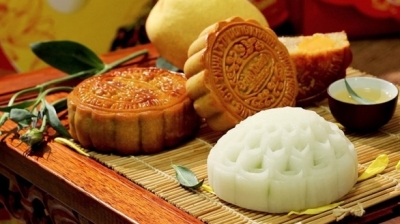Moon cakes are an indispensable part of Vietnamese people’s celebrations of the Mid-Autumn Festival, which is held annually on the 15th day of the eight lunar month.

There are two types of moon cake; banh nuong (brown baked cake) and banh deo (snow skin sticky cake). The making of moon cakes has many steps, including processing the ingredients, making the crust and mixing the stuffing.
A traditional moon cake is filled with sliced lemon leaves, young kumquat, wampee, salted egg yolk, sausage, roast chicken, melon seeds and almond. All of the ingredients must be selected carefully and they must be mixed and cooked harmoniously together so that one can taste the flavour of each component.
One of the most important steps in making a moon cake is dealing with its crust. Bakers use cooked glutinous rice powder, sugar and water to make crust of banh deo. The baker must pay attention to the weather and adjust the water volume while kneading dough in order to avoid making the crust too dry.
The crust of banh nuong should be presented in a shining colour to highlight its patterns on the surface. The crust should be crispy at the first bite and taste rich on the inside.
Each dough piece is pressed in a circle. Bakers then press the filling into the middle of each circle and roll it into a ball and then flatten it.
After the filling is added, each flattened circle is pressed in the mould to form the moon cake shape.
The making of banh deo is completed after it is removed from the mould since the cake is made from cooked glutinous rice powder.
Banh nuong, however, has to undergo additional steps. After being removed from the mould, it is brushed with egg wash, which will give the cake its colour, and finally the cake is baked until it turns golden brown.
Ha Noi has many moon cake bakeries; each one has its own secret recipe to attract customers. A village in Ha Noi has a long history of making moon cake; Xuan Dinh village, now called Xuan Tao ward, Bac Tu Liem district.
According Vice Chairman of Xuan Tao ward People’s Committee, Nguyen Duy Tuan, the ward had around 70 households running moon cake bakeries, but now just 30 of them are still baking.
Each year when the Mid-Autumn Festival comes, a large number of moon cakes are made in the village and then brought to the market.
One the most famous bakeries in the village is Do The Gia shop, founded by Do Manh The, the fourth descendants of Do family. Do family started their confectionary business in 1902 and launched two shops in Hang Duong and Hang Vai streets in Ha Noi’s Old Quarter by Do Nang Dien, alias Ly Dien.
In The’s opinion, the decisive factor in making a quality a moon cake is the preparation of the ingredients. High quality and well-processed ingredients help to make a high quality cake.
He is proud to say that all of the ingredients for moon cake in his bakery are totally processed by hand. As his bakery has around 20 employees, The strictly and directly inspects every step of the making procedure to ensure the steps are done in the right way.
The always bears in mind his father’s lessons which taught him that a baker should make his cakes with all of his heart so that customers will remember the distinct flavour in his products.
In recent years, although many moon cake bakeries have tried to created many different styles of their products by replacing traditional fillings with new ingrdients, such as; taro, black beans, taro, salangane bird nest, shark fins or even chocolate; a large number of customers still choose to buy traditional flavoured moon cakes, which are made from natural ingredients with all of the heart of the bakers like The.